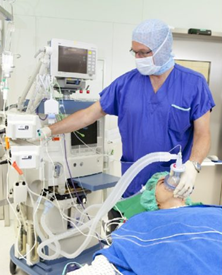Exposures can occur when handling the gases or liquids, leakage from equipment, from the patient or animal breathing circuit during delivery of anesthesia, or as exhaled by the patient or research animal (e.g., during recovery).
Workers may be exposed to waste anesthetic gases when:
Clinical/dental
- When leaks occur in the anesthetic breathing machine, breathing system, hoses, and connections; this happens if the connectors, tubing, and valves are not maintained and/or tightly connected.
- When anesthetic gas seeps over the lip of the patient’s mask or from endotracheal coupling, particularly if the mask is poorly fitted (e.g., during pediatric anesthesia)
- During dental operations, especially with patient mouth-breathing or talking
- Leaks from around tracheal tubing
Animal
- During induction of anesthesia, both while using liquid anesthetics (drop method) and induction boxes; this is more common with rodents.
- Opening of induction boxes
- Failure to promptly discontinue the flow of anesthetic gas prior to removing an animal from an anesthetic breathing line (e.g. removing and replacing animals on a single nose cone)
- Misuse or over-saturation of charcoal canister in scavenging system
All applications
- When anesthetic gases escape during hookup and disconnection of the anesthesia system or scavenging system
- When filling refillable vaporizers
- Leaks between subject and facemask/nose cone
- Spills of liquid anesthetics
- When the anesthesia system is flushed or purged at the conclusion of a procedure
- Insufficient ventilation system or gas scavenging system
Anesthetic gases must always be used in a well-ventilated room (greater than or equal to six (6) air changes per hour) with no recirculation of locally exhausted air.
Anesthetic gases must always be used with a scavenging/ventilation mechanism that eliminates inhalation exposure to the worker.
